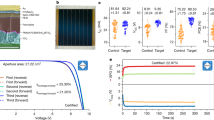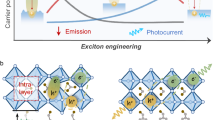Abstract
In the last decade, solution-processed quantum dot/nanocrystal solar cells have emerged as a very promising technology for third-generation thin-film photovoltaics because of their low cost and high energy-harnessing potential. Quantum dot solar cell architectures developed to date have relied on the use of bulk-like thin films of colloidal quantum dots. Here, we introduce the bulk nano-heterojunction concept for inorganic solution-processed semiconductors. This platform can be readily implemented by mixing different semiconductor nanocrystals in solution and allows for the development of optoelectronic nanocomposite materials with tailored optoelectronic properties. We present bulk nano-heterojunction solar cells based on n-type Bi2S3 nanocrystals and p-type PbS quantum dots, which demonstrate a more than a threefold improvement in device performance compared to their bilayer analogue, as a result of suppressed recombination.
This is a preview of subscription content, access via your institution
Access options
Subscribe to this journal
Receive 12 print issues and online access
$209.00 per year
only $17.42 per issue
Buy this article
- Purchase on Springer Link
- Instant access to full article PDF
Prices may be subject to local taxes which are calculated during checkout




Similar content being viewed by others
References
Luther, J. M. et al. Schottky solar cells based on colloidal nanocrystal films. Nano Lett. 8, 3488–3492 (2008).
Ma, W. et al. Photovoltaic performance of ultrasmall PbSe quantum dots. ACS Nano 5, 8140–8147 (2011).
Pattantyus-Abraham, A. G. et al. Depleted-heterojunction colloidal quantum dot solar cells. ACS Nano 4, 3374–3380 (2010).
Brown, P. R. et al. Improved current extraction from ZnO/PbS quantum dot heterojunction photovoltaics using a MoO3 interfacial layer. Nano Lett. 11, 2955–2961 (2011).
Jasieniak, J., MacDonald, B. I., Watkins, S. E. & Mulvaney, P. Solution-processed sintered nanocrystal solar cells via layer-by-layer assembly. Nano Lett. 11, 2856–2864 (2011).
Panthani, M. G. et al. Synthesis of CuInS2, CuInSe2, and CuInxGa1–xSe2 (CIGS) nanocrystal ‘inks’ for printable photovoltaics. J. Am. Chem. Soc. 130, 16770–16777 (2008).
Guo, Q., Hillhouse, H. W. & Agrawal, R. Synthesis of Cu2ZnSnS4 nanocrystal ink and its use for solar cells. J. Am. Chem. Soc. 131, 11672–11673 (2009).
Luther, J. M. et al. Stability assessment on a 3% bilayer PbS/ZnO quantum dot heterojunction solar cell. Adv. Mater. 22, 3704–3707 (2010).
Tang, J. et al. Quantum dot photovoltaics in the extreme quantum confinement regime: the surface-chemical origins of exceptional air- and light-stability. ACS Nano 4, 869–878 (2010).
Gur, I., Fromer, N. A., Geier, M. L. & Alivisatos, A. P. Air-stable all-inorganic nanocrystal solar cells processed from solution. Science 310, 462–465 (2005).
Wang, X. et al. Tandem colloidal quantum dot solar cells employing a graded recombination layer. Nature Photon. 5, 480–484 (2011).
Choi, J. J. et al. Solution-processed nanocrystal quantum dot tandem solar cells. Adv. Mater. 23, 3144–3148 (2011).
Barkhouse, D. A. R., Pattantyus-Abraham, A. G., Levina, L. & Sargent, E. H. Thiols passivate recombination centers in colloidal quantum dots leading to enhanced photovoltaic device efficiency. ACS Nano 2, 2356–2362 (2008).
Tang, J. et al. Colloidal-quantum-dot photovoltaics using atomic-ligand passivation. Nature Mater. 10, 765–771 (2011).
Yu, G., Gao, J., Hummelen, J. C., Wudl, F. & Heeger, A. J. Polymer photovoltaic cells—enhanced efficiencies via a network of internal donor–acceptor heterojunctions. Science 270, 1789–1791 (1995).
Oosterhout, S. D. et al. The effect of three-dimensional morphology on the efficiency of hybrid polymer solar cells. Nature Mater. 8, 818–824 (2009).
Ren, S. et al. Inorganic–organic hybrid solar cell: bridging quantum dots to conjugated polymer nanowires. Nano Lett. 11, 3998–4002 (2011).
Barkhouse, D. A. R. et al. Depleted bulk heterojunction colloidal quantum dot photovoltaics. Adv. Mater. 23, 3134–3138 (2011).
Rath, A. K., Bernechea, M., Martinez, L. & Konstantatos, G. Solution-processed heterojunction solar cells based on p-type PbS quantum dots and n-type Bi2S3 nanocrystals. Adv. Mater. 23, 3712–3717 (2011).
Johnston, K. W. et al. Efficient Schottky–quantum-dot photovoltaics: the roles of depletion, drift, and diffusion. Appl. Phys. Lett. 92, 122111 (2008).
Zhao, N. et al. Colloidal PbS quantum dot solar cells with high fill factor. ACS Nano 4, 3743–3752 (2010).
Snaith, H. J. et al. Efficiency enhancements in solid-state hybrid solar cells via reduced charge recombination and increased light capture. Nano Lett. 7, 3372–3376 (2007).
Ohnesorge, B. et al. Minority-carrier lifetime and efficiency of Cu(In,Ga)Se2 solar cells. Appl. Phys. Lett. 73, 1224–1226 (1998).
Urban, J. J., Talapin, D. V., Shevchenko, E. V., Kagan, C. R. & Murray, C. B. Synergismin binary nanocrystal superlattices leads to enhanced p-type conductivity in self-assembled PbTe/Ag2Te thin films. Nature Mater. 6, 115–121 (2007).
Ko, D.-K., Urban, J. J. & Murray, C. B. Carrier distribution and dynamics of nanocrystal solids doped with artificial atoms. Nano Lett. 10, 1842–1847 (2010).
Talapin, D. V. & Murray, C. B. PbSe nanocrystal solids for n- and p-channel thin film field-effect transistors. Science 310, 86–89 (2005).
Wolcott, A. et al. Anomalously large polarization effect responsible for excitonic red shifts in PbSe quantum dot solids. J. Phys. Chem. Lett. 2, 795–800 (2011).
Lee, J.-S., Kovalenko, M. V., Huang, J., Chung, D. S. & Talapin, D. V. Band-like transport, high electron mobility and high photoconductivity in all-inorganic nanocrystal arrays. Nature Nanotech. 6, 348–352 (2011).
Fafarman, A. T. et al. Thiocyanate-capped nanocrystal colloids: vibrational reporter of surface chemistry and solution-based route to enhanced coupling in nanocrystal solids. J. Am. Chem. Soc. 133, 15753–15761 (2011).
Nag, A. et al. Metal-free inorganic ligands for colloidal nanocrystals: S2−, HS−, Se2−, HSe−, Te2−, HTe−, TeS32−, OH−, and NH2− as surface ligands. J. Am. Chem. Soc. 133, 10612–10620 (2011).
Acknowledgements
The authors acknowledge financial support from Fundació Privada Cellex Barcelona and the European Union FP7 IRG programme (contract PIRG06-GA-2009-256355). The authors thank N. van Hulst and M. Kuttge for assistance with the transient photoluminescence measurements and for providing access to the focused ion beam (FIB) system for device inspection.
Author information
Authors and Affiliations
Contributions
G.K. supervised the study and wrote the manuscript. A.K.R. fabricated all the devices and contributed to all characterization techniques and data analysis. M.B. synthesized the materials and contributed to material characterization data analysis. L.M. contributed to device characterization and data analysis. F.P.G.A. contributed to data analysis. J.O. contributed to structural characterization and analysis. All authors provided inputs to data analysis, discussed the results and assisted in manuscript preparation.
Corresponding author
Ethics declarations
Competing interests
The authors declare no competing financial interests.
Supplementary information
Supplementary information
Supplementary information (PDF 2483 kb)
Rights and permissions
About this article
Cite this article
Rath, A., Bernechea, M., Martinez, L. et al. Solution-processed inorganic bulk nano-heterojunctions and their application to solar cells. Nature Photon 6, 529–534 (2012). https://doi.org/10.1038/nphoton.2012.139
Received:
Accepted:
Published:
Issue Date:
DOI: https://doi.org/10.1038/nphoton.2012.139
This article is cited by
-
Evaporated nanometer chalcogenide films for scalable high-performance complementary electronics
Nature Communications (2022)
-
Influence of thickness and annealing temperature on properties of solution processed bismuth sulfide thin films
Journal of Materials Science: Materials in Electronics (2022)
-
Interfacial engineering of Bi2S3/Ti3C2Tx MXene based on work function for rapid photo-excited bacteria-killing
Nature Communications (2021)
-
Flexible high-performance graphene hybrid photodetectors functionalized with gold nanostars and perovskites
NPG Asia Materials (2020)
-
Cascade surface modification of colloidal quantum dot inks enables efficient bulk homojunction photovoltaics
Nature Communications (2020)



